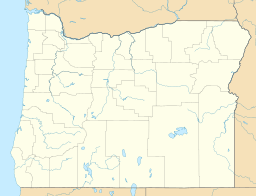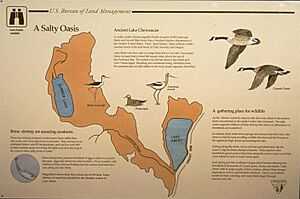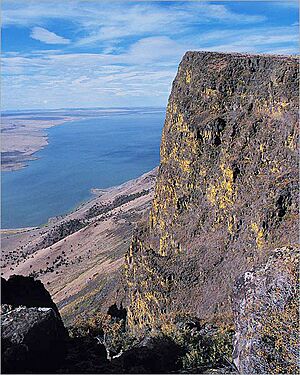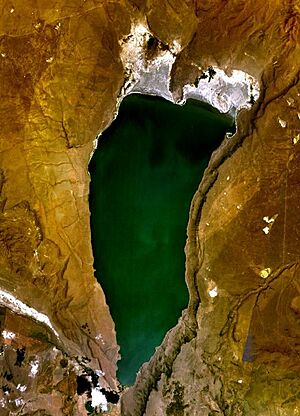Lake Abert facts for kids
Quick facts for kids Lake Abert |
|
|---|---|
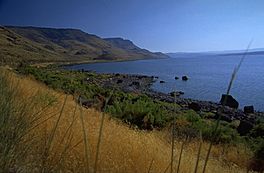
East shore of Lake Abert
|
|
| Location | Lake County, Oregon |
| Coordinates | 42°38′49″N 120°13′26″W / 42.647°N 120.224°W |
| Type | Endorheic |
| Primary inflows | Chewaucan River |
| Catchment area | 820 square miles (2,100 km2) |
| Basin countries | United States |
| Max. length | 15 mi (24 km) |
| Max. width | 7 mi (11 km) |
| Surface area | 57 square miles (150 km2) |
| Max. depth | 11 ft (3.4 m) |
| Surface elevation | 4,259 ft (1,298 m) |
Lake Abert (also called Abert Lake) is a big, shallow, and very salty lake in Lake County, Oregon, United States. It is about 15 miles (24 km) long and 7 miles (11 km) wide at its widest point. The lake is located northeast of the small town of Valley Falls, Oregon. Explorer John C. Fremont named the lake in 1843 after Colonel John James Abert.
No fish can live in Lake Abert because its water is so salty. However, many tiny brine shrimp thrive there. These shrimp are a very important food source for many different kinds of shorebirds. Lake Abert is also a key stop for birds migrating along the Pacific flyway.
Contents
Ancient Lake Chewaucan
Long ago, the dry land around Lake Abert was very green and wet. During the Pleistocene epoch (the Ice Age), huge parts of south-central Oregon were covered by large lakes and wetlands. As the last ice age ended, melting snow and rain filled the low areas. This created a giant freshwater lake called Lake Chewaucan. This ancient lake covered about 461 square miles (1,190 km2) and was up to 375 feet (114 m) deep.
Lake Chewaucan covered the areas where Lake Abert and Summer Lake are today. The last time the water was very high was about 13,000 years ago. Scientists have found signs that humans might have lived in the area around the ancient lake. Evidence from the Paisley Caves suggests people were there as far back as 14,300 years ago.
Lake Chewaucan began to dry up as the Ice Age ended. As the water disappeared, salts and other minerals became very concentrated in the remaining water. This process formed the salty Lake Abert and Summer Lake. Today, these two lakes are about 20 miles (32 km) apart. They are the only parts left of the huge Lake Chewaucan.
Lake Environment
Lake Abert is an endorheic lake. This means it has no outlet, so water flows in but does not flow out. The lake has a long, triangular shape. It is about 15 miles (24 km) long. It starts about 1 mile (1.6 km) wide at its south end and widens to 7 miles (11 km) at its north end.
Even though it's a big lake, covering about 57 square miles (150 km2), it's quite shallow. The deepest part is only about 11 feet (3.4 m). On average, it's about 7 feet (2.1 m) deep.
The east side of Lake Abert is next to Abert Rim. This is a very steep cliff that rises over 2,500 feet (760 m) above the lake. On the west side, there's a long ridge called Coglan Buttes. The Coleman Hills are to the north. The only river that flows into Lake Abert all year round is the Chewaucan River. It enters the lake from the south.
The land around Lake Abert is quite dry. Most of the rain and snow falls in winter. The Chewaucan River gets its water mainly from melting snow. Sometimes, summer thunderstorms bring a little more water from Abert Rim. Because the lake has no outlet, the water evaporates, leaving behind salts and minerals. This makes the water very high in sodium carbonates and common salt. You can see thick crusts of minerals on rocks along the shore.
Wildlife and Ecology
Fish cannot live in Lake Abert because the water is too salty and alkaline. However, tiny brine shrimp are very common here. The lake is an excellent home for many kinds of shorebirds. It's one of the few places in Oregon where snowy plovers nest.
Lake Abert is also a vital stop for many birds migrating along the Pacific flyway. Each year, tens of thousands of birds visit the lake. These include eared grebes, Wilson's phalaropes, red-necked phalaropes, American avocets, killdeer, and northern shovelers. During the summer, you might also see black terns, Forster's terns, white-faced ibis, Clark's grebes, and black-necked stilts.
Many Canada geese, snow geese, Ross’ geese, and different duck species are also common. Bird watchers have counted over 20,000 ducks at the lake at one time. More than 12,000 ring-billed gulls and California gulls have also been seen. Nearby, you might spot sage grouse and burrowing owls. Large birds of prey like bald eagles, ferruginous hawks, and peregrine falcons hunt in the Lake Abert area.
History of Discovery
The first time Lake Abert was written about was by John Work. He was leading a fur trapping trip for the Hudson's Bay Company. Work wrote about his visit in his journal on October 16, 1832. He called it Salt Lake. His journal also suggests that other trappers might have been to the lake before him.
Lieutenant John C. Fremont officially named Lake Abert in 1843. Fremont was on a mapping trip through central and southern Oregon. He and his Army mapping team were creating maps of the Oregon Territory. Fremont named the lake to honor Colonel John James Abert. Colonel Abert was the chief of the Army's mapping engineers.
On December 20, 1843, Fremont wrote about finding and naming Lake Abert:
We turned a point of the hill on our left, and came suddenly in sight of another and much larger lake... I gave to it the name Lake Abert, in honor of the chief of the corps to which I belong....
In 1986, a large wildfire burned about 9,854 acres (3,988 ha) along the west side of the lake. After the fire, some areas were replanted with a type of grass. Other areas were left to grow back naturally.
Human Activities
Today, the Bureau of Land Management (BLM) looks after Lake Abert and the land around it. There is an area on the southwest shore where cattle are allowed to graze. This area covers about 6,886 acres (2,787 ha) of BLM land. The main plants here are different types of grasses and big sagebrush.
Because the lake water is so salty, people don't do many fun activities on the lake itself. Swimming or spending too much time in the water could be harmful. Sometimes, kayakers paddle on the lake. There are no special campgrounds at Lake Abert, but the BLM allows camping in many areas. The most common fun activity at Lake Abert is bird watching.
A small business started collecting brine shrimp from Lake Abert in 1979. Brine shrimp can handle very salty water and can even survive freezing in winter. This makes them the only animals that live in the lake itself. The amount of brine shrimp collected from the lake is small.
Location
Lake Abert is in Lake County, in south-central Oregon. It is about 30 miles (48 km) north of Lakeview, Oregon. You can reach it by driving on U.S. Route 395. This highway runs along the east side of the lake for about 18 miles (29 km). There are signs along the highway at viewpoints where you can stop and look at the lake. Lake Abert is also about 130 miles (210 km) southwest of Burns, Oregon, also on Highway 395.


